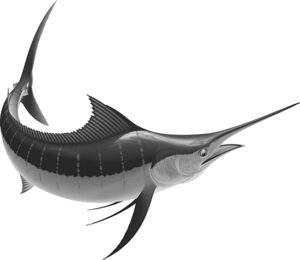Embarking on a charter boat with rods and reels, cruising towards the vast expanse of the sea, the pursuit of Blue Marlin beckons. As one of the most coveted big game fish globally, with a record-breaking specimen weighing 1024 pounds in Florida, the question arises: How does one successfully catch a Blue Marlin in the Gulf? The straightforward answer lies in trolling with substantial dead bait, whether whole or cut.
While some anglers may opt for live bait, trolling with dead bait, preferably whole, proves more effective in attracting and hooking these majestic creatures. The deceased fish, when trolled, mimics a natural swimming motion in the water, providing an enticing allure for Marlin. While there are additional nuances to this approach, we delve deeper into the specifics below.
Spotting The Four Marlin Species
Blue Marlin
- Best Bait: Whole blackfin tuna, skipjack, or bonito.
- Best Destinations: Destin, Florida, holds the record for a 1046-pound Blue Marlin.
- What To Look For: Schools of flying fish, mackerel, and other fish balls, along with diving birds, indicate Marlin presence.
Black Marlin
- Best Bait: Mackerel, bonito, or squid.
- Best Destinations: Off the coast of Santa Rosa Beach and Destin, Florida.
- What To Look For: Warm water, near shore, along shallow coral reefs, and targeting smaller predatory fish.
Striped Marlin
- Best Bait: Live or dead mackerel, sardines, and big eye.
- Best Destinations: Destin, Panama City, and along the panhandle.
- What To Look For: Water temperatures between 65°F-75°F, trolling past structures, reefs, wrecks, and oil rigs.
White Marlin
- Best Bait: Smaller baitfish such as anchovies, mackerel, herring, or bonefish.
- Best Destinations: Throughout the Gulf of Mexico, the Atlantic, and around Miami.
- What To Look For: Water temperatures above 66°F, targeting mid to top levels of the water column.

How To Catch Marlin
The primary method for capturing Blue Marlin involves trolling with a dead bait trailing behind the boat, maintaining a speed under five knots. An oily fish, when trolled effectively, often proves successful in attracting Marlin. Patience is key, allowing the Marlin to hook itself naturally. Attempting to set the hook aggressively may result in the hook floating out of the fish’s mouth.
Blue Marlin Fishing Techniques
- Pitch Bait: A sight fishing technique involving pitching a pre-rigged rod with a dead bait fish towards a curious Marlin.
- Trolling: Widely regarded as the most effective method, trolling with leaders and trailing a 1–2-foot mackerel or other suitable bait.
- Harpoon: While intense, sinking a harpoon into a sizable Marlin provides better control during the fight.
Blue Marlin Fishing Tips
- Use Natural Bait: Dead fish, when trolled correctly, exhibit a more natural swimming pattern, making them preferable to live bait.
- Artificial Baits: Artificial lures can be effective, especially those resembling larger bait fish.
- The Right Gear: Opt for 100-pound monofilament line, an 80-class reel with a lever drag, and a 12 to 16-weight rod based on the fish’s size.
Finding Their Habitat
- Water Temperature: Look for temperatures above 70°F and below 85°F, with specific focus on the Gulf Coast, especially around Destin and the panhandle.
- Baitfish Schools: Marlin often trail structures until nighttime when they venture out in pursuit of stray baitfish or squid.
Gulf Coast Laws
- Minimum Size Limit: Blue Marlin must be longer than 99 inches, while White Marlin should exceed 66 inches.
- Daily Bag Limit: One billfish per day, irrespective of the species.
- Season: Open year-round, with warmer months like August, September, and October considered optimal.

Frequently Asked Questions
- How Long Does It Take to Reel in a Marlin? Typically, it takes about 45 minutes to an hour, but larger fish may extend the duration.
- Where Can You Catch Marlin? Marlin can be found globally, with the Gulf of Mexico, especially around Destin, Panama City, and Santa Rosa Beach, being ideal.
- What Do You Do with a Marlin After You Catch It? Most anglers release Blue Marlin to conserve the species. However, some may choose to keep the catch within the legal limits for consumption or display.
Mastering the art of Blue Marlin fishing in the Gulf demands a strategic combination of bait, techniques, and equipment. Whether trolling with natural or artificial bait, understanding their habitat, adhering to regulations, and employing patience are key elements in the pursuit of this magnificent big game fish.
Images/Source: CharterFishingDestin





